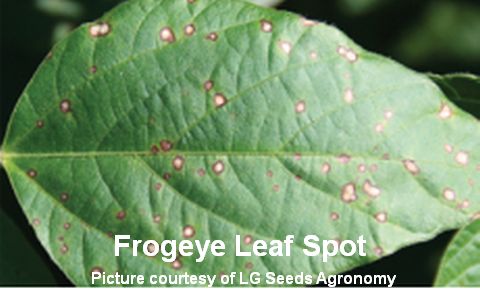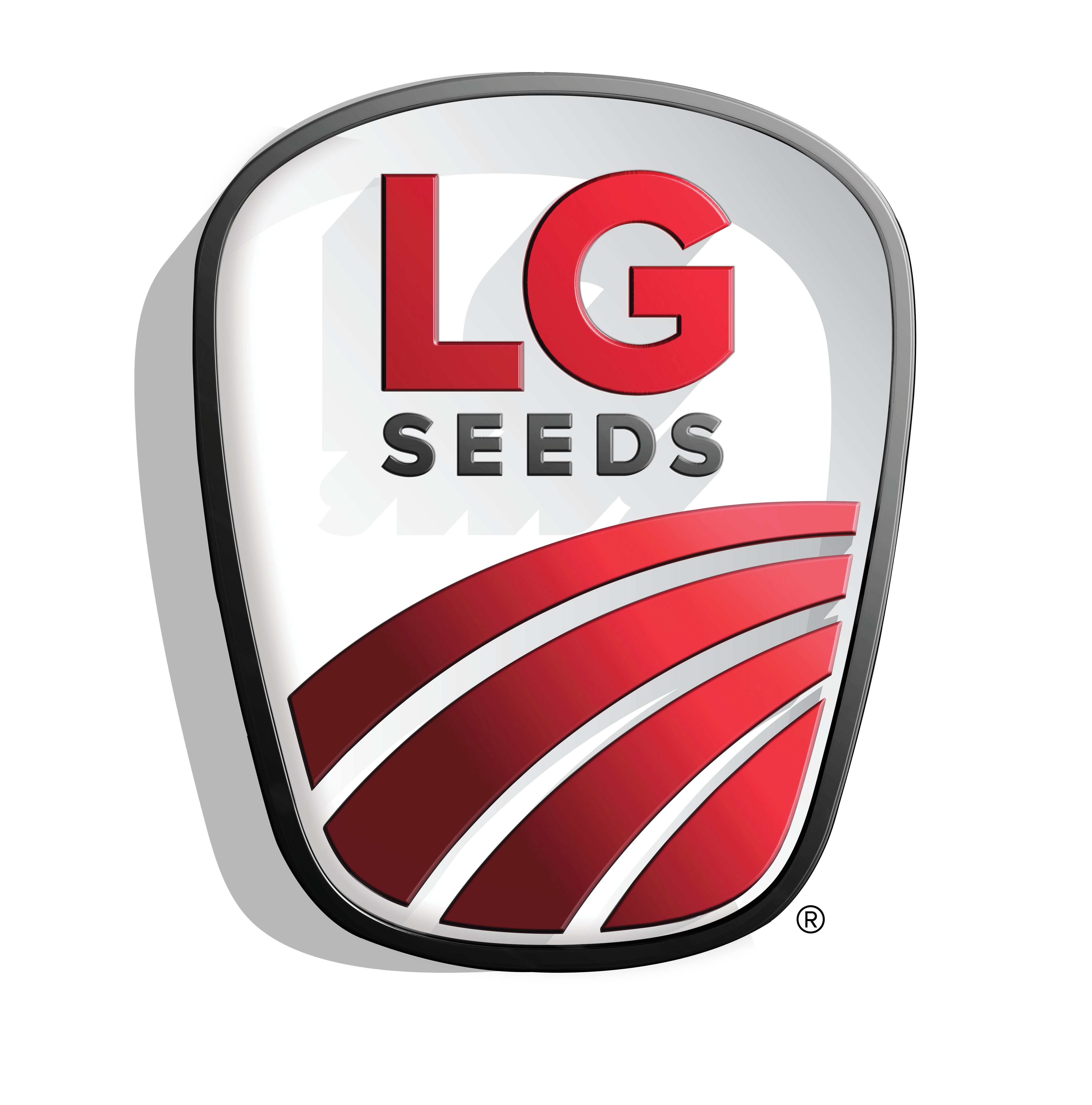AGRONOMICSUPPORT
YOU CAN TAKETO THE FIELD
Frogeye Leaf Spot
Frogeye leaf spot (FLS) is considered a southern disease in hot and humid environments. However it shows up in the central and eastern Corn Belt to cause economic damage in susceptible varieties. Areas of infestation match the path of hurricane weather flow such as hurricane Dennis in 2005. It is a residue related disease and usually more prevalent in no-till and reduced tillage systems. FLS is caused by the fungus Cercospora sojina. Periods of warm and humid weather increase the potential of disease spread and resulting yield loss. Resistant varieties and fungicides are effective in disease control. It is important to properly identify the disease and use stewardship to prevent the development of fungicide resistance.
Identity
 First appearing on the upper side of the soybean leaves are small, dark, water-soaked lesions where the centers will change color from gray to brown to light tan. Lesions of FLS are spots with a reddish-brown border; where the center deteriorates and presents a shot hole appearance. Lesions on underside of leaf have a grayish appearance.
First appearing on the upper side of the soybean leaves are small, dark, water-soaked lesions where the centers will change color from gray to brown to light tan. Lesions of FLS are spots with a reddish-brown border; where the center deteriorates and presents a shot hole appearance. Lesions on underside of leaf have a grayish appearance.
 FLS can be easily confused with Brown spot or Septoria leaf spot in the lower canopy. Brown spot lesions do not have purple or reddish brown borders but have small or irregular lesions with yellow areas on the leaves. Brown spot lesions can have a brick red color underside of the leaf. Brown spot lesions usually occur earlier in the season in cool and wet conditions. Target spot appears like Frogeye, but lesions rarely have the purple margin. FLS develops later in the late vegetative and reproductive stages in warmer temperatures. FLS causes significant yield loss whereas Brown spot does not. Frogeye can cause elongated stem lesions and develop on pods in severe infestations, they are dark spots that penetrate through the pod wall.
FLS can be easily confused with Brown spot or Septoria leaf spot in the lower canopy. Brown spot lesions do not have purple or reddish brown borders but have small or irregular lesions with yellow areas on the leaves. Brown spot lesions can have a brick red color underside of the leaf. Brown spot lesions usually occur earlier in the season in cool and wet conditions. Target spot appears like Frogeye, but lesions rarely have the purple margin. FLS develops later in the late vegetative and reproductive stages in warmer temperatures. FLS causes significant yield loss whereas Brown spot does not. Frogeye can cause elongated stem lesions and develop on pods in severe infestations, they are dark spots that penetrate through the pod wall.
Disease development
The fungus overwinters in soybean residues. It can carry over several years in minimum and no-till systems. A slow developing disease with explosive potential in later disease cycles through the season. Young (newer) leaves are more susceptible, with most infections occurring after onset of flowering. Lesion development occurs in about 10 days. Huge quantities of conidia (spores) are formed in each lesion for increased disease severity through the season, especially in warm and humid conditions with frequent rains. Spores travel from leaf-to-leaf, plant-to-plant, and field-to-field on air movement and winds. The disease is more prevalent in river bottoms or areas where fogs hang over the fields until mid-morning through the month of August. Disease severity is usually highest in irrigated fields.
Disease Management
- Select soybean varieties resistant/tolerant to frogeye, especially if your field has a history of FLS, minimum tillage or in a valley or bottom where high humidity is common.
- Fungicides are effective in disease control. Susceptible varieties should be treated if lesions are observed in the lower or middle canopy by the R3 growth stage and weather conditions are hot and humid through August. See Diseases of Soybean: Fungicide Efficacy for Control of Foliar Soybean Diseases = http://www.soybeanresearchinfo.com/pdf_docs/Fungicide_efficacy_BP161W_2017.pdf
- Populations of the FLS fungus Cercospora sojina have developed resistance to strobilurin fungicides in several states. Use fungicide tank mixes with multiple active ingredients to prevent the development of fungicide resistance and obtain disease control.
- Disease levels can be kept low by tillage or crop rotation to reduce soybean residue on the soil surface.
 Frogeye leaf spot is a sporadic disease that is likely to present itself in years of good growing conditions, with frequent rain fall and warm weather. Disease control is easily achieved by selection of resistant varieties or use of fungicides.
Frogeye leaf spot is a sporadic disease that is likely to present itself in years of good growing conditions, with frequent rain fall and warm weather. Disease control is easily achieved by selection of resistant varieties or use of fungicides.
Sources and Additional Information:
Dorrance, Ann and Dennis Mills. 2010. Frogeye Leaf Spot of Soybean. AC-53-10. The Ohio State University. http://ohioline.osu.edu/ac-fact/pdf/0053.pdf
Crop Protection Network. 2017. Frogeye Leaf Spot https://cropprotectionnetwork.org/encyclopedia/soybeans/foliar-diseases/frogeye-leaf-spot/
Note: The information in this issue is based upon field observations and third-party information. Since variations in local conditions may affect the information and suggestions contained in this issue, LG Seeds disclaims legal responsibility therefore. Always read and follow label instructions.
LG Seeds and design are trademarks of AgReliant Genetics, LLC.
Download a copy of this Technical Bulletin: Tech_190 - Frogeye updated 2018






Agronomist & Technical Team Agronomist Support